Bolton Castle
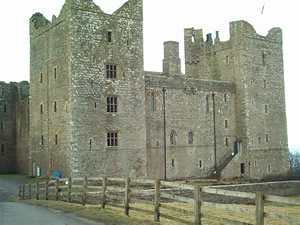
Seen from the North-West [Enlarge]
View map (SE 034 918): Multimap| Google | Live Local
Bolton castle was built by Richard, Lord Scrope, Richard III's steward of the Royal Household on the site of a previous manor house. Licence to crenellate was awarded in 1379 but the castle was almost complete by then, a contract being awarded to the master mason John Lewyn for the most accessible east side in 1378 (it is likely he was also architect for the rest of the castle). Bolton is a quadrangular castle with four ranges around a central courtyard. At each corner are set bulky rectangular towers, with further small towers at the centre of the longer northern and southern walls. The western of the ranges is still habitable but the north-east was slighted after John Scrope held the castle for the King during a year long siege (ending 1645) in the civil war, though the north-east tower didn't actually fall until a storm of 1761.
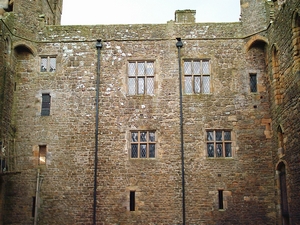
The western range viewed from within the courtyard. Notice the machicolations above the doorways. [Enlarge]
The castle itself is remarkably uniform, with little to distinguish one range from another. Entrance was gained via a passageway through the east range, protected by the south-east tower, portcullis, doors and murder holes. This south-eastern tower and the adjacent parts of the southern and eastern ranges formed a self contained unit that may well have served as a secure retreat when necessary and probably also served as guard and mess hall. The uniformity continues in the courtyard, where five doors, each barred by a portcullis, offer no indication of their relative importance. The four doors in each corner were further protected by overhanging machicolations. The courtyard also had defence in mind in that the windows are on the whole small and suitable for archers rather than large for the comfort of the residents. Lines of raised stones in the courtyard indicate livestock enclosures built during the civil war.
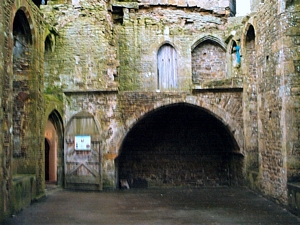
The chapel, showing the private gallery above. [Enlarge]
The ground floors of the towers and ranges form a sequence of barrel vaulted chambers. These formed the workshops, buttery, pantry, stores, stables, brewery, a well chamber and the like. Higher came handsome living quarters, including a two storey great hall in the northern range. There was even a separate guest suite in the west range. The five story tall towers provided even further accommodation and it is in the south-west of these that Mary Queen of Scots was held in 1568. Each of the private apartments and most communal rooms had their own garderobe. There was also a sophisticated series of flues and chimneys to carry smoke away from the various fires. Interestingly most of the interconnecting stairways spiral the opposite direction (anticlockwise) to that normally employed. The reason for this is unknown. The castle's chapel, dedicated to St. Anne, was located in the southern range. This had a private gallery for the use of the Scrope family, accessed via a stairway from the solar in the south-west tower. The central tower of the southern wall supplied room for priests chambers off the chapel.
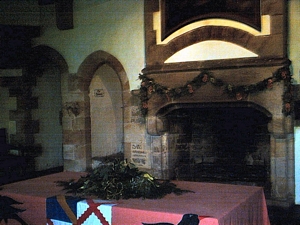
The fireplace in the solar. Note the door to the left leading to the Nursery and the further door giving access to the stairs up to the bed chambers [Enlarge]
The family's private accommodation was within the south-west tower, hence this is where Mary Queen of Scots stayed (though effectively imprisoned Mary was still treated as her rank deserved and hence took use of the grandest of the residence available). The accommodation available included a solar, looking south over the castle gardens, bed chambers, a nursery and several garderobes. It is still possible to climb to the battlements of the tower, which afford splendid views of the surrounding countryside.
The northern range once contained the well chamber and great hall, buttery and great kitchen. At the base of the buttress tower is a dark, tiny oubliette, a dungeon in the sense we might use the word today, accessed only via a trapdoor above. In direct contrast to this horrid hole the great hall rises through two stories above, its grandness only now hinted at by the remaining walls.
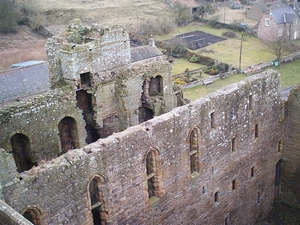
The northern range viewed from atop the south-west tower. [Enlarge]
Some of the castle is still in use today, though not for purposes the Scropes would have recognised! One of the guest chambers now forms the gift shop, and the tea room is housed in what was once the guest hall, original used for receiving visitors and messengers and holding conference. The castle gardens have also been recreated, complete with a still developing privet maze, though not quite on the original scale.
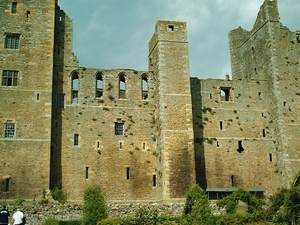
The southern range seen from the castle gardens [Enlarge]
Sources:
- Personal visit
- Bolton Castle: Guide Book
- A. Pettifer, English Castles: A Guide by Counties, Boydell & Brewer, Woodbridge (1995) ISBN: 0 85115 782 3
- N. Harris, Castles of England, Scotland and Wales, George Philip, London (1991) ISBN: 0 7537 0753 5
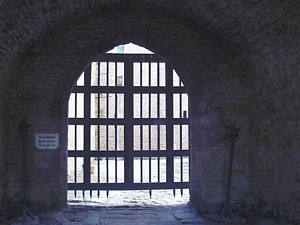
View through the entrance passageway into the courtyard. [Enlarge]